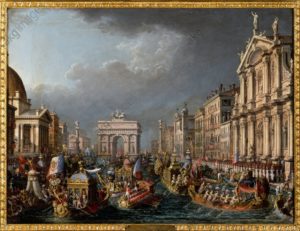
A painting, now in Milan’s Pinoteca Ambrosina, of Napoleon’s Entry into Venice on Friday November 29 1807, by Giuseppe Borsato
Italy’s major cities count at least one world-famous piazza. From south to north: Naples: Piazza del Plebiscito; Rome: Piazza Navona, Piazza Barberini, and Piazza di Spagna; Florence: Piazza della Signoria; Bologna: Piazza Maggiore; Genoa: Piazza de Ferrari; Turin: Piazza San Carlo; Milan: Piazza del Duomo; Padua: Piazza delle Erbe and Prato della Valle, the largest public square in Italy and one of the largest in Europe; Verona: Piazza Bra; Trieste: Piazza Unità d’Italia, and Venice: Piazza San Marco.
On May 26, 1805 Napoleon was crowned King of Italy (reigned 1806-14). He soon realized that he needed a large site there for his administration as well as lodgings for his (potentially significant) court when on a state visit. He chose Piazza San Marco, the political and religious center of the old Venetian Republic, and selected the Zecca (mint), the Libreria Marciana (the great library and masterpiece of Renaissance architect Jacopo Sansovino (1486-1570)), and the Procuratie Nuove to house his royal palace. Unfortunately, they weren’t sufficiently large for his additional needs: a vast room for public ceremonies, a monumental staircase, and a main entrance onto the piazza. So he ordered the construction of the Ala (Wing) Napoleonica opposite the Basilica, which today houses the Correr Museum.
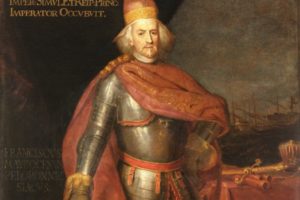
Morosoni
On here until May 3, to celebrate the 400th anniversary of his birth, is the exhibition: “Francesco Morosoni: the Last Serenissima’s Hero Between History and Myth”. It includes personal objects, books, portolans, globes, and relics of classical Greek art, which record his character and interests. While military documents model ships and fortresses, trophies and weapons seized from the Ottomans all depict this man of war and his exploits, especially his conquest of the Peloponnese (1683-8). However, perhaps he is best remembered for the cannonball fired from his ship during the siege of Athens, which badly damaged the Parthenon on September 26, 1687. In his report to the Venetian government he described the event as a “fortunate shot”. After he conquered Athens a few months later in 1688 he tried to loot Athena’s and Poseidon’s horses and chariots from the Parthenon’s still-standing west pediment, but the sculptures fell to the ground and smashed.
Doge from 1688-1694, in her book, The Venetian Empire: a Sea Voyage, Jan Morris reports that he “always dressed in red from top to toe and never went into action without his cat beside him.” The cat was embalmed and is on display in the Correr Museum.

David’s Portrait of Napoleon
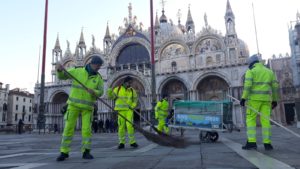
Garbage Collection in St. Mark’s Square Photo credit: Ewout Kieckens
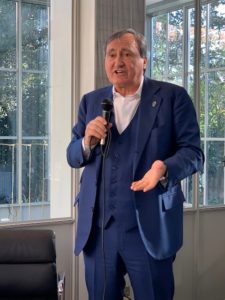
Mayor Luigi Brugnaro during a press conference with Stampa Estera about the MOSE. Photo credit: Lucy Gordan
Napoleon never lived in his “Venetian Palace” which wasn’t completed until 1836 during the Austrian occupation, some 15 years after the “Little Corporal”’s (one of Napoleon’s 21 nicknames) death in exile on the island of St. Helena, but nonetheless he is said to have called St. Mark’s Square, “the drawing room of Europe”.
Napoleon’s remark, although its authenticity is unproved, is still valid today, at least partially thanks to two rival cafés on opposite sides of the Square: Caffè Florian and Gran Caffè Quadri.
According to Ian Littlewood’s A Literary Companion: Venice: “Coffee had first been brought to the attention of the Venetians in 1585 when Gianfrancesco Morosoni , who was bailo in Constantinople, reported to the Senate that the Turks were accustomed to drink ‘a black water, boiled up as hot as they could bear it, which is distilled from a seed called kahvé and which they say has the property of making a man stay awake.’ By the middle of the next century coffee was on sale in Venice as a medicine. Its popularity increased, imports rose, and in 1683 the first coffee shop opened under the arcade of the Procuratie Nuove, where Florian’s still sets out its tables.”
I returned home Saturday (February 8) evening from a three-day visit to Venice with over 30 colleagues from the Associazione della Stampa Estera in Italia (The Foreign Press Assciation). We were guests of AVA (Associazione Veneziana Albergatori). We visited the Centro Maree, where their records about tides go back to the 1500s and they explained in scientific detail the anomalies of November 12th (the third highest tide ever documented) and how they can otherwise predict the acque alte with forewarning; city hall for a meeting with politically independent Mayor Luigi Brugnaro and Chief of the municipal police Marco Agostini; an early-morning sweep and garbage collection in St. Mark’s Square; St. Mark’s Basilica to survey the damage and the luckily spared Doge’s Palace; the MOSE; and backstage at the Fenice theater. On our second evening we enjoyed an aperitivo at Caffè Florian followed by bellinis (a cocktail of prosecco and peach purée) and supper at Harry’s Bar. Our menu: an antipasto of baccalà mantecato or cream of dried cod with polenta, tuna tartare, marinated salmon, Carpaccio Cipriani, meat tartare, Cipriani buffalo mozzarella, and baby artichokes from the laguna island of Torcello; scampi Carlina with pilaf rice; and apple pie with vanilla ice cream.
Caffè Florian was founded on December 29, 1720 (so is celebrating its 300th birthday) and named “Alla Venezia Trionfante” or “Triumphant Venice”. After Café le Procope founded in 1686 in Paris and Baroque Haus Zum Arabischen Coffe Baum on Klein Fleischergasse 4 in Leipzig founded by Heinrich Schütze in 1694, it’s the oldest café in Europe continuously open in the same location. The first café ever to open to women, after a few months Venetians began calling it “Florian’s” after its founder Floriano Francesconi. Over the centuries among its world-famous patrons are poet and satirist Giuseppe Parini, political writer Silvio Pellico, poet Ugo Foscolo, Goethe, Dickens, Lord Byron, Rousseau, Canova, Dickens, D’Annunzio with actress Eleanora Duse, Stravinsky, Proust, and Modigliani. Its Sala del Senato, one of its six beautifully decorated rooms, is the birthplace of the international art fair, Il Biennale. For more details consult Danilo Reato’s, Il Caffé Florian, Filippi editore, 1984 and Robert de Laroche’s Florian: Venezia 1720, 2008.

Caffè Florian today
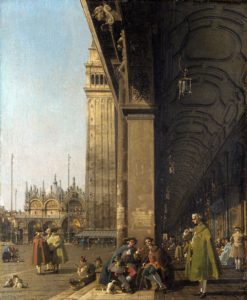
A painting (1750) of Piazza San Marco, now in London’s National Gallery, by Canaletto. It shows Caffè Florian on the right.
In spite of the several steps up from the Square’s pavement, on November 12th the acqua alta flooded Florian’s. Fortunately, the water reached just below the seats of its red-velvet cushioned sofas. Within two hours after reopening only two days later, the Caffè had received 2,500 congratulatory messages on Facebook.
Shunned by Italian patriots, Lord Byron and Rousseau were also clients of the more bustling, pretentious pro-Austrian Gran Caffè Quadri, located under the arcade of the Procuratorie Vecchie at the Square’s pavement level so that November’s flood waters, much higher than at Florian’s, reached the wall frescoes luckily protected by Plexiglas panels. Although unnoticeable now, damage was considerable and Quadri’s was closed for several days.
Several websites report that either a shop owned by Turkish merchants selling coffee or a restaurant called “Il Rimedio” or “The Cure” thanks to its sweet wine Malvasia on sale there, thought to “reinvigorate the limbs and awaken the spirit”, date to 1638 at Quadri’s location. For certain on May 28, 1775 Giorgio Quadri returned after many years to his hometown from Corfu with his Greek wife Naxina. It was her idea to purchase “Il Rimedio” and open a coffee house, even if by this time in Venice she had over 200 competitors, twenty-four of which were located on the Piazza. Quadri’s guestbook includes Stendhal, Richard Wagner, De Balzac, Dumas father, and more recently Gorbachev, Mitterand, and Woody Allen.
Redecorated in 2018 by the ingenious French architect Philippe Starck, Quadri’s is the only restaurant on St. Mark’s Square. Since 2011 it’s been run by the Alajmo family from Padua, owners of Le Calandre with three Michelin stars. Quadri’s has one.
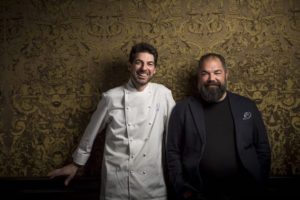
Max and Raf Alajmo Photo credit: Marco Peruzzo-Different Media Productions
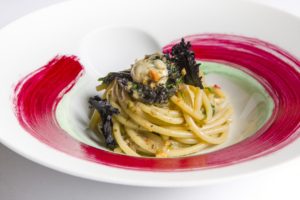
Max Alajmo’s spaghetti with garlic, olive oil, peperoncino, oysters, and kale Photo credit: Marie-Pierre Morel
Both Florian’s and Quadri’s have tables in the Square and an orchestra each. Although rivals, they alternate playing music so as not to out sound each other.
Just down the street from Napoleon’s entrance is another historical restaurant with a literary connection, Harry’s Bar. Declared a national landmark in 2001 by the Italian Ministry for Cultural Affairs, it was luckily undamaged on November 12th so it always remained open.
It was founded in 1931 by Giuseppe Cipriani (1900-80) thanks to the generosity of the rich young Bostonian Harry Pickering, a regular guest at the nearby Hotel Europa where Cipriani was bartender. The story goes that Pickering’s family cut him off financially because of his excessive drinking habits so Cipriani lent him 10,000 lire, then about $500, to cover his bill. Two years later Pickering returned to pay back his debt and gave Cipriani an additional 40,000 lire to open his open his own bar, which he named for his benefactor.
Harry’s Bar, birthplace of the Bellini and Carpaccio and famous for its dry martini served in a stemless glass, was a favorite of Hemingway and is mentioned in Evelyn Waugh’s novel Brideshead Revisited as a frequent haunt of the principal characters Charles Ryder and Sebastian Flyte while they were in Venice. Other V.I.P. clients include Toscanini, Marconi, Charlie Chaplin, Alfred Hitchcock, Humphrey Bogart, Jimmy Stewart, Truman Capote, Orson Welles, Baron Philippe de Rothschild, Onasis, Barbara Hutton, Peggy Guggenheim, Tareq Salahi, George Clooney, and Woody Allen.
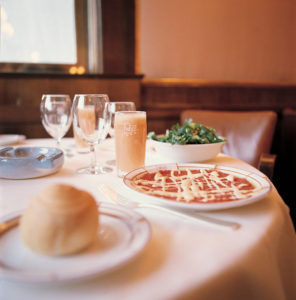
A Bellini and a plate of Carpaccio at Harry’s Bar
Today Harry’s Bar is the anchor to a global brand linked to the Cipriani name. In Venice they also own the restaurant Harry’s Dolci on the Giudecca. In New York City, the Ciprianis run the restaurants Harry Cipriani in The Sherry Netherlands, Cipriani 42nd Street, Cipriani Dolci in Grand Central Station, Cipriani Wall Street and Cipriani Downtown in Soho, a travel company, and a catering service. Their brand includes lines of pasta, sauces, olive oils, coffee, books and kitchenware. For more information read Arrigo Cipriani’s (born 1932) Harry’s Bar: A Venetian Legend.
